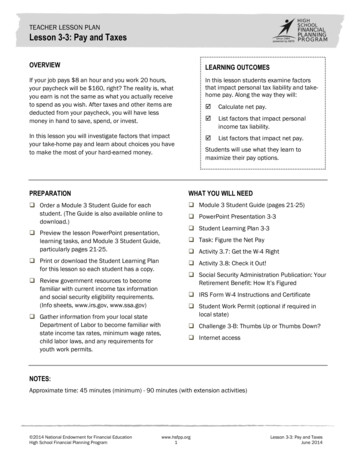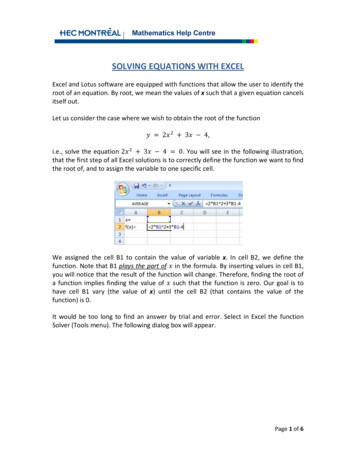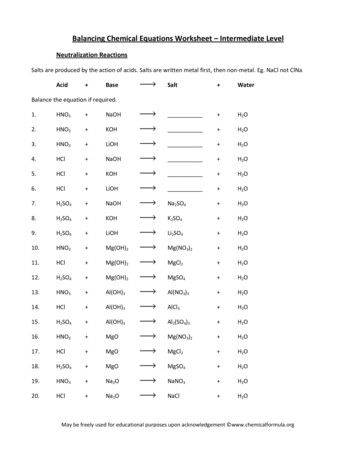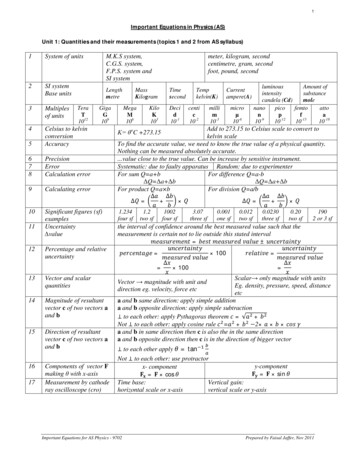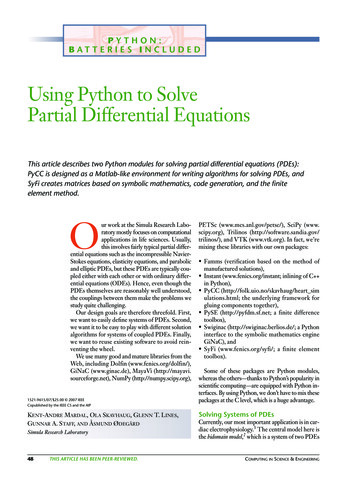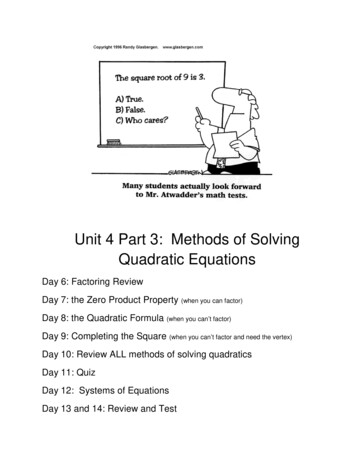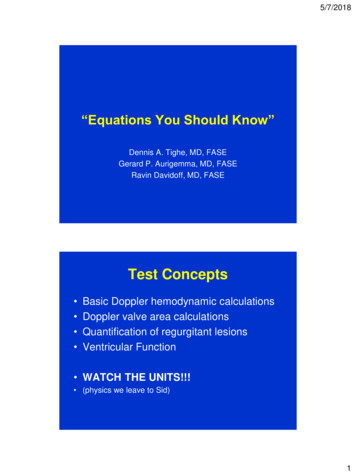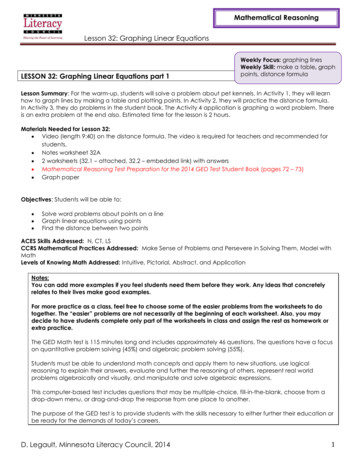
Transcription
Mathematical ReasoningLesson 32: Graphing Linear EquationsLESSON 32: Graphing Linear Equations part 1Weekly Focus: graphing linesWeekly Skill: make a table, graphpoints, distance formulaLesson Summary: For the warm-up, students will solve a problem about pet kennels. In Activity 1, they will learnhow to graph lines by making a table and plotting points. In Activity 2, they will practice the distance formula.In Activity 3, they do problems in the student book. The Activity 4 application is graphing a word problem. Thereis an extra problem at the end also. Estimated time for the lesson is 2 hours.Materials Needed for Lesson 32: Video (length 9:40) on the distance formula. The video is required for teachers and recommended forstudents. Notes worksheet 32A 2 worksheets (32.1 – attached, 32.2 – embedded link) with answers Mathematical Reasoning Test Preparation for the 2014 GED Test Student Book (pages 72 – 73) Graph paperObjectives: Students will be able to: Solve word problems about points on a lineGraph linear equations using pointsFind the distance between two pointsACES Skills Addressed: N, CT, LSCCRS Mathematical Practices Addressed: Make Sense of Problems and Persevere in Solving Them, Model withMathLevels of Knowing Math Addressed: Intuitive, Pictorial, Abstract, and ApplicationNotes:You can add more examples if you feel students need them before they work. Any ideas that concretelyrelates to their lives make good examples.For more practice as a class, feel free to choose some of the easier problems from the worksheets to dotogether. The “easier” problems are not necessarily at the beginning of each worksheet. Also, you maydecide to have students complete only part of the worksheets in class and assign the rest as homework orextra practice.The GED Math test is 115 minutes long and includes approximately 46 questions. The questions have a focuson quantitative problem solving (45%) and algebraic problem solving (55%).Students must be able to understand math concepts and apply them to new situations, use logicalreasoning to explain their answers, evaluate and further the reasoning of others, represent real worldproblems algebraically and visually, and manipulate and solve algebraic expressions.This computer-based test includes questions that may be multiple-choice, fill-in-the-blank, choose from adrop-down menu, or drag-and-drop the response from one place to another.The purpose of the GED test is to provide students with the skills necessary to either further their education orbe ready for the demands of today’s careers.D. Legault, Minnesota Literacy Council, 20141
Mathematical ReasoningLesson 32: Graphing Linear EquationsLesson 32 Warm-up: Solve the pet kennel questionTime: 5 MinutesWrite on the board: A kennel charges a fee of 12 and 8 a day for cats and 12 a day fordogs.Basic Questions: What is the cost to board a cat for a week? A dog?o 12 8(7) 68o 12 12(7) 96Extension Questions: Write an expression for the cost of boarding a cat for a weeko 12 8dWrite an expression for the cost of boarding a dog for a weeko 12 12dFor how many dogs and how many cats is the price per day the same?o Since the ratio of the price is 2 to 3, the cost is the same for 2 dogs 3 cats 24Lesson 32 Activity 1: Graphing with PointsTime: 30 Minutes1. Use Notes 32A to teach how to graph linear equations by making a table.2. Do the examples from the notes on the board and have students take their own notes.3. For each equation, make a table and then make a graph.4. Practice with Worksheet 32.1. The worksheet does not have a table, but have the studentsadd an x/y table for each problem.Lesson 32 Activity 2: The Distance FormulaTime: 20-25 Minutes1. Draw a coordinate plane on the board. Show two points such as (-2,3) and (2,3) for which it iseasy to see how many units apart they are (4 in this case) because one of the coordinates isthe same.2. Do several examples of points that lie on either the same x or the same y.3. The distance formula is used to find the distance between two points on a line that are notD. Legault, Minnesota Literacy Council, 20142
Mathematical ReasoningLesson 32: Graphing Linear Equationseasy to count.4. Explain how the distance formula is related to the Pythagorean Theorem (which you will studyin a later lesson) of a2 b2 c2.5. Example: Find the distance between the points (8,5) and (4, -3). Show the points on thegraph.Note to teacher: The example should have (-4)2 and (-8)2. Results are the same.6. Practice with Worksheet 32.2. Do one together first.Lesson 32 Activity 3: Practice QuestionsTime: 15-20 Minutes1. Have students work in the student book pages 72-73.2. Do the example on page 72 on the board. Make a table to show how we choose x valuesand substitute them into the table to obtain the y value.3. Explain again that when x 0, it is the x-intercept because this is where the line crosses the xaxis. It is a good idea to graph x 0.4. Explain again that when y 0, it is the y-intercept. It is a good idea to graph y 0.5. You should always graph at least 3 points to make sure you didn’t make a mistake.D. Legault, Minnesota Literacy Council, 20143
Mathematical ReasoningLesson 32: Graphing Linear EquationsLesson 32 Activity 4 Application: Graph the Kennel ProblemTime: 15-20 Minutes1. Graph the word problem from the warm up activity about pet kennels.2. Recall the equations: To kennel a cat, it’s 12 8 a day. For the dog, it is 12 12 a day.3. Make a table for each one and then graph each line by putting in a number of days andsolving for y. The table below is an example. Students may write different numbers for x.4.Cat: 12 8x yx daysy costDog: 12 12x yx daysy cost120124336348552572768796The graph should look similar to the one below (except lines should start at origin).5. Follow up questions: Why do you think the line for the dog goes up faster? (more expensive)6. What is that line called? (the slope). We will study the slope soon.Lesson 32: Finish Early?Time: 10 Minutes1. Write an equation, make a table, and make a graph for how much pay you earn per week.2. Hint: Your pay rate multiplied by your hours equals your pay.3. Example: If you make 12 an hour, then 12x y.D. Legault, Minnesota Literacy Council, 20144
Mathematical ReasoningLesson 32: Graphing Linear EquationsNotes 32A: How to Graph a Linear EquationD. Legault, Minnesota Literacy Council, 20145
Mathematical ReasoningLesson 32: Graphing Linear EquationsD. Legault, Minnesota Literacy Council, 20146
Mathematical ReasoningLesson 32: Graphing Linear EquationsD. Legault, Minnesota Literacy Council, 20147
Mathematical ReasoningLesson 32: Graphing Linear EquationsD. Legault, Minnesota Literacy Council, 20148
Mathematical ReasoningLesson 32: Graphing Linear EquationsD. Legault, Minnesota Literacy Council, 20149
Mathematical ReasoningLesson 32: Graphing Linear EquationsWorksheet 32.1 Graphing LinesD. Legault, Minnesota Literacy Council, 201410
Mathematical ReasoningLesson 32: Graphing Linear EquationsWorksheet 32.1 AnswersD. Legault, Minnesota Literacy Council, 201411
Video (length 9:40) on the distance formula. The video is required for teachers and recommended for students. Notes worksheet 32A 2 worksheets (32.1 – attached, 32.2 – embedded link) with answers Mathematical Reasoning



